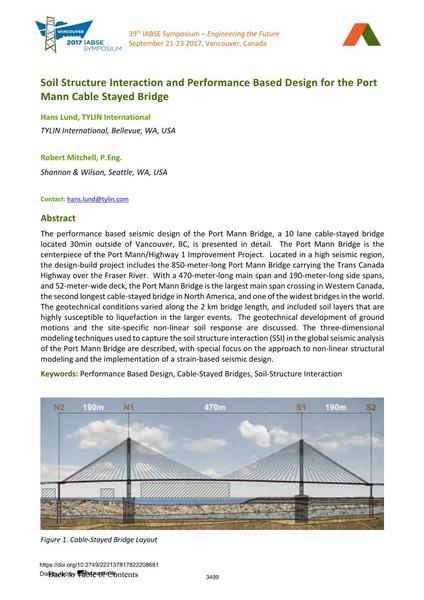Soil Structure Interaction and Performance Based Design for the Port Mann Cable Stayed Bridge

|
|
|||||||||||
Bibliografische Angaben
| Autor(en): |
Hans Lund
(TYLIN International, Bellevue, WA, USA)
Robert Mitchell (Shannon & Wilson, Seattle, WA, USA) |
||||
|---|---|---|---|---|---|
| Medium: | Tagungsbeitrag | ||||
| Sprache(n): | Englisch | ||||
| Tagung: | IABSE Symposium: Engineering the Future, Vancouver, Canada, 21-23 September 2017 | ||||
| Veröffentlicht in: | IABSE Symposium Vancouver 2017 | ||||
|
|||||
| Seite(n): | 3499-3506 | ||||
| Anzahl der Seiten (im PDF): | 8 | ||||
| Jahr: | 2017 | ||||
| DOI: | 10.2749/222137817822208681 | ||||
| Abstrakt: |
The performance based seismic design of the Port Mann Bridge, a 10 lane cable-stayed bridge located 30min outside of Vancouver, BC, is presented in detail. The Port Mann Bridge is the centerpiece of the Port Mann/Highway 1 Improvement Project. Located in a high seismic region, the design-build project includes the 850-meter-long Port Mann Bridge carrying the Trans Canada Highway over the Fraser River. With a 470-meter-long main span and 190-meter-long side spans, and 52-meter-wide deck, the Port Mann Bridge is the largest main span crossing in Western Canada, the second longest cable-stayed bridge in North America, and one of the widest bridges in the world. The geotechnical conditions varied along the 2 km bridge length, and included soil layers that are highly susceptible to liquefaction in the larger events. The geotechnical development of ground motions and the site-specific non-linear soil response are discussed. The three-dimensional modeling techniques used to capture the soil structure interaction (SSI) in the global seismic analysis of the Port Mann Bridge are described, with special focus on the approach to non-linear structural modeling and the implementation of a strain-based seismic design. |
||||
| Stichwörter: |
Schrägseilbrücken Boden-Bauwerk-Interaktion
|
||||

